Building muscle and getting stronger is an admirable fitness goal that requires dedication and hard work. You’re committed to hitting the gym, lifting weights, and ensuring your meals are packed with protein. However, the process of building muscle can be complex.
While lifting weights and increasing your exercise can certainly contribute to muscle growth, achieving significant results requires pushing your muscles beyond their limits and allowing them adequate time to recover and grow.
Speaking of recovery and growth, let’s take a moment to understand what this entails.
in the context of recovery and growth, “it’s essential to understand the post-workout discomfort known as delayed onset muscle soreness (DOMS). This discomfort arises when your muscle fibers undergo slight tearing during exercise, particularly during strength-based training. This tearing of muscle fibers is a normal and vital aspect of the muscle-building process”. The degree of these tears depends on the intensity of your workout. Generally, the greater the tearing, the more favorable the results are likely to be.
This is where protein plays a crucial role…
For those tears to heal and for new stronger muscles to form, your body requires amino acids, which are abundantly found in protein. By replenishing your body with dietary protein, you provide the necessary building blocks for muscle repair and growth after exercise.
But why is protein essential for the body overall?
Proteins are the fundamental building blocks of life. They are vital for good health, as studies have shown that protein is highly satisfying, making you feel fuller with less food.
Apart from increasing muscle mass, “Protein offers numerous health benefits such as repairing tissues, strengthening bones, promoting healthy skin and hair, providing energy, and aiding in the transportation of oxygen through the bloodstream”.
Additionally, protein contributes to the production of antibodies that fight off infections and illnesses, as well as the maintenance of healthy cells and the creation of new ones.
Now, you might wonder…
 How much protein do I need to consume to support muscle growth?
How much protein do I need to consume to support muscle growth?
Muscle tissue primarily consists of protein, so it comes as no surprise that a high-protein diet can assist in building more muscle.
The exact amount of protein you should consume per day is a matter of debate. “Traditional bodybuilding advice suggests consuming one gram of protein per pound of body weight to support muscle growth. However, the scientific recommendations vary based on factors such as age, fitness level, and specific body composition goals”.
Defining the optimal protein intake can be challenging because our individual protein needs depend on various factors, including age, weight, height, gender, general health, physical activity levels, and the type and intensity of the activities we engage in. It also takes into account our body composition and existing muscle mass.
Here are ten Protein-Rich Foods
When we think of protein, the usual suspects like beef, chicken, fish, and eggs come to mind. These are fantastic sources of high-quality protein, with a large egg providing around six grams of protein. But guess what? There are some surprising foods out there that pack even more protein than an egg, along with some additional nutrition benefits. Let’s delve in together
The first on the list is…
-
1 – Pumpkin Seed:
Don’t underestimate the power of these tiny seeds. In just one ounce of shelled pumpkin seeds, you’ll find eight grams of protein. Impressive, right? But that’s not all! Pumpkin seeds are also loaded with heart-healthy fats, fiber, magnesium, and zinc. Magnesium promotes better sleep, while zinc supports a healthy immune system. These seeds are rich in antioxidants, vitamins, minerals, and, of course, that valuable protein. Try adding them to salads, trail mixes, and smoothies, or simply enjoy a handful as a snack. They’re affordable and easy to incorporate into your diet.
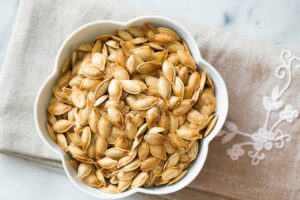
-
2 – Chickpea Pasta
Picture a bowl of pasta, but not your regular kind. We’re talking about chickpea pasta, which boasts a whopping 14 grams of protein per serving. Even standard pasta provides around seven grams, so chickpea pasta is a winner in the protein department. Plus, you’ll get an additional fiber boost of nearly eight grams. It’s made from dried chickpea flour and offers a milder taste compared to whole wheat or other pasta varieties. So, if you’re not a fan of certain pasta types, give chickpea pasta a try. It’s delicious, protein-packed, and high in fiber.

-
3 – Sprouted Grain Bread:
Did you ever think of bread as a high-protein food? Well, all bread contains some protein but sprouted grain bread takes it to the next level. In just two slices, you’ll get eight grams of protein. And guess what? You can increase that protein content even further by adding eggs, sandwich meats, or peanut butter. Sprouted grain bread not only delivers protein but also tends to be higher in fiber, derived from whole grains. Start your day with a toast topped with peanut butter or whip up a delicious breakfast sandwich with eggs for that protein-packed goodness.
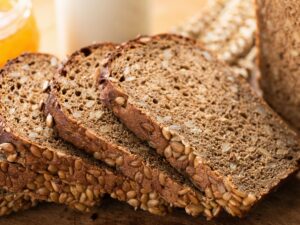
-
4 – Cottage Cheese:
Now, here’s an unexpected protein powerhouse. A cup of cottage cheese contains a whopping 23 grams of protein, surpassing many other cheeses. Cottage cheese may not be your typical cheese board option, but it’s time to give it a chance. You can enjoy it sweet by adding cinnamon and fruit for a high-protein bowl, or go delicious by mixing it with salsa and using it as a dip. Cottage cheese offers not only protein but also calcium and vitamin D, essential for maintaining bone health.

-
5 – Hemp Seeds:
Get ready for a superfood that delivers on protein content. Three tablespoons of hemp seeds pack an impressive 10 grams of plant-based protein. These little wonders are incredibly versatile and can be sprinkled into oatmeal, added to muffins or smoothies, or even incorporated into pasta sauces. Hemp seeds are rich in protein, fiber, and healthy fats, which help keep you feeling full and satisfied. They have a mild flavor, making them an excellent choice for both kids and adults seeking essential healthy fats, protein, and fiber.
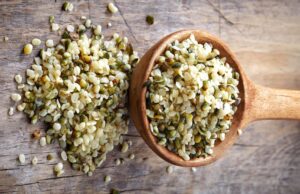
Check Out Our List Of The Best Supplements For Building Muscle, Shredding Muscle, Recovery, And Great Health, and Wellness Products! Purchase IFBNewsfeed.Org‘s Apparels Here: IFBNewsfeed.Org
-
6 – Black Beans:
Beans, specifically black beans, are a fantastic source of plant-based protein. Half a cup of black beans contains eight grams of protein, along with a good dose of fiber and antioxidants. These beans are incredibly versatile and affordable, making them a pantry staple. From tacos to soups to salads, black beans can be added to a wide range of dishes, boosting both protein and fiber intake. They are a nutrient powerhouse, offering various vitamins and minerals, including folate and iron.
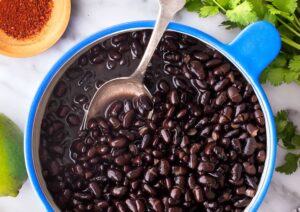
-
7 – Quinoa:
If you’re seeking a plant-based complete protein, look no further than quinoa. With seven grams of protein per cooked cup, quinoa is a superstar. What makes it even more impressive is that it contains all the essential amino acids our bodies need. Not only will quinoa provide you with a good protein boost, but it also offers additional nutrients like iron, magnesium, and phosphorus. Use quinoa as a base for salads, soups, or enjoy it as a delicious side dish. This versatile grain is a fantastic addition to any meal.
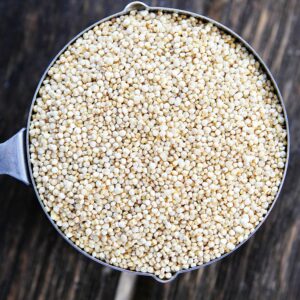
-
8 – Peanut Butter:
Ah, the classic peanut butter! It’s not only a childhood favorite but also a fantastic source of plant-based protein. Two tablespoons of peanut butter deliver eight grams of protein. Opt for natural peanut butter, made from just peanuts and a pinch of salt, to avoid added sugars and unhealthy oils. Spread it on toast, use it as a dip for fruits or veggies, or simply enjoy it by the spoonful (we won’t judge!). Peanut butter is a versatile and affordable way to add protein to your diet.
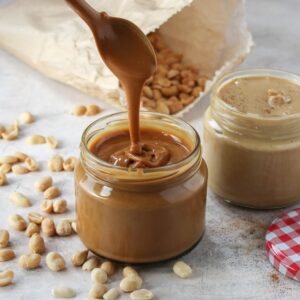
-
9 – Green Peas:
Green peas contain a higher protein content compared to most other vegetables, making them a valuable protein source. With approximately nine grams of protein per cup, along with ample dietary fiber, green peas offer a nutrient-rich addition to meals.
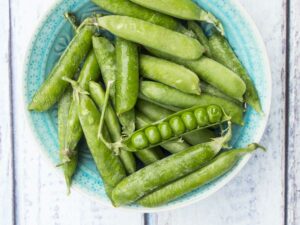
-
10 – Almonds:
Crunchy and delicious, almonds are not only a tasty snack but also a good source of plant-based protein. In just one ounce (about 23 almonds), you’ll get around six grams of protein. Almonds are packed with heart-healthy fats, fiber, and vitamin E, making them a well-rounded choice. They promote sustained energy levels, thanks to their healthy fats, and offer additional nutrients like manganese and magnesium. Keep a stash of almonds handy for a quick and nourishing snack on the go.
Related Articles:
- Do “Protein Powders” Contain Ingredients That May Not Be Listed? Here Are “The 9 Ingredients” That Your Protein Powder Should Not Have
- Male Bodybuilder’s Diet: How To Diet As “Male Bodybuilder” Does. Here’s “The Perfect Diet” For Competitive Bodybuilders
- How “To Build Insane Muscle Mass” While Staying Shredded On Any Type Of Diet. “Build Muscle Mass” And Stay Fitter”

- Get a refreshing blend of vitamins, amino acids, and natural caffeine for a calm stimulation with LivPur ENERGY!
- $5.95 Ground Shipping On Any Purchase In The US! – Shop Now!
- Free Shipping on US orders over $49 USD and 5 lbs or less at eVitamins.com!
Wrapping up
Fueling your diet with protein daily is important for both your overall health and building strong muscles. “Protein is like fuel for your muscles, helping them grow and recover after intense workouts”.
Luckily, there are plenty of options when it comes to high protein sources. “You can choose from animal-based sources like meat and dairy, as well as plant-based sources such as beans, nuts, and seeds”. By incorporating protein-rich foods into your meals, you’ll be giving your muscles the nutrients they need to thrive.
Remember, “it’s not just about what you eat but also how you exercise. Make sure to stay active and engage in regular exercise to complement your protein-rich diet“. By combining the two, you’ll be on your way to achieving your muscle-building goals.
For More News And Daily Updates, Follow IFBNewsfeed.Org on Facebook, Twitter, and Instagram. Comment, Like, And Share With Everyone Who May Need To Be Updated With The Most Recent Fitness/Bodybuilding/Powerlifting And CrossFit News.






